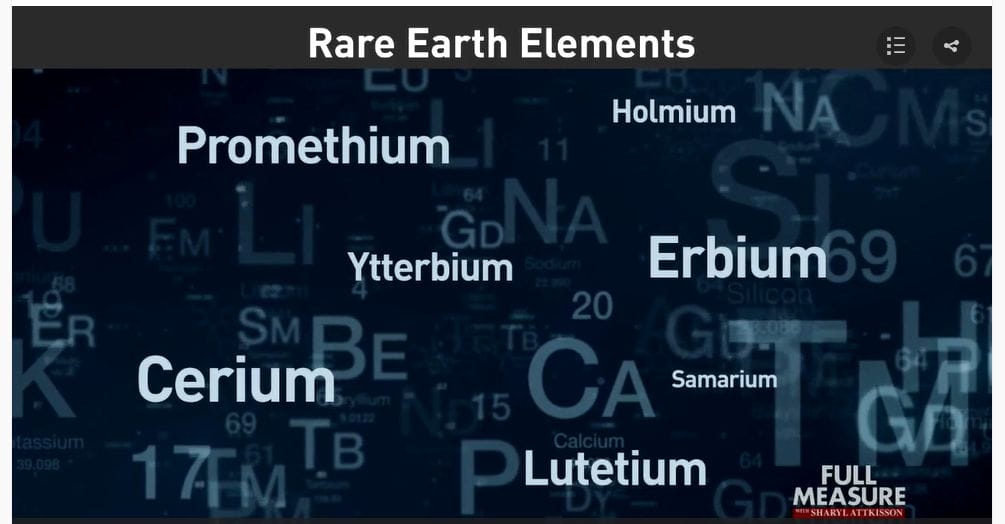
During the frenzy leading into the election, there was an emergency declaration you may not have heard about. In late September, President Trump declared the U.S. dependence on China for so-called ‘rare earth’ minerals a ‘national emergency’. Those minerals are essential to technology from our phones to our top-level defense weapons. In today’s cover story, Lisa Fletcher takes us on a deep dive, literally, beneath the earth’s surface into the ocean for ‘the battle below.’
Tim Shank: For thousands of years, tens of thousands of years, humans have used the ocean. They’ve relied on the ocean for sources of food, for transportation, and now we’re looking more and more for industry, for oils, and whatnot and for resources.
Tim Shank is an oceanographer and a biologist. When he’s on dry ground he works at Woods Hole, the Massachusetts coast town that’s given its name to one the world’s leading marine research organizations: The Woods Hole Oceanographic Institution. But his research goes deep, to the furthest reaches of the ocean as far as 35-thousand feet beneath the surface.
Shank: When I started 20 years ago, the conversation of mineral resources and mining and harvesting from the deep sea wasn’t even a topic, and now it’s a topic of almost every conversation. Every deep sea biology meeting we have is discussing deep sea mining at the forefront.
The reason deep-sea mining has become such a hot topic is because of what‘s down there, billions -potentially trillions- of dollars’ worth of valuable minerals, including so-called rare earths, with names you never learned in college chemistry like, Gallium, critical for semiconductors in cellphones, and 5G communications. Neodymium, creating super-strong magnets for our electric vehicles and wind turbines. And Yttrium and Terbium, used for laser targeting and weapons in combat vehicles. In all, seventeen metal elements found together at the bottom of the periodic table, and at the bottom of the ocean.
Shank: In the deep ocean, there’s a literal race, like we had to the Moon, there’s a race to the deep ocean for resources that we don’t even know are there yet.
The same elements are found on land, they’ve been mined for years, but through strategic planning and totalitarian support over three decades, one nation has cornered the market: China.
While the race to the moon during the Cold War pitted the U.S. against the Soviet Union, there is a new race to control the commodities that control almost every facet of modern life, both commercial and military.
Nate Picarsic: The Chinese Communist Party develops and deploys a consolidated industrial plan to capture key sectors of the future economy.
Nate Picarsic is an expert on China who has advised the Pentagon and intelligence agencies. He sees a critical national security vulnerability.
Picarsic: The United States imports over 80% of its rare earth elements from China. Many aircraft engines require rare earth elements, many aircraft parts and panels depend upon specific alloys that benefit from rare earth elements, and then everything from missile guidance and radar has also include rare earth elements. The Chinese industrial policy has delivered the Chinese communist party absolute competitive advantage in the rare earth field.
It’s not a new problem, but for the U.S., it became more pressing this year. In July, the Chinese announced sanctions against U.S. defense contractor Lockheed Martin to limit exports of key rare earth materials the company uses in weapons systems.
Picarsic: They’re sending a signal that they’re willing to restrict the export from China, these goods that are critical for U.S. aerospace and defense industry.
The Pentagon has been pushing for more production for several years. Encouraging new domestic sources of the rare earths, and providing financial backing to help start new mines or reopen old ones.
One of those is Mountain pass in California’s Mojave desert. The military dollars helped a new company get the mine started again after the previous owner went bankrupt, partly because of china’s control of the rare earth market.
Anthony Marchese: We look at this as surety of supply. We look at this as a patriotic act.

Visit The Sharyl Attkisson Store today
Unique gifts for independent thinkers
Proceeds benefit independent journalism
Anthony Marchese is a veteran of both the U.S. Army and Wall Street. He’s also getting into the race, leading a Texas-based company that plans to start mining near El Paso.
Marchese: It’s unrealistic to assume that American industry will catch up to the Chinese in 10 or 15 years’ time. Our number one concern is, will we be able to supply what the United States needs? Number one. We believe we’ll be able to do that.
Demand for rare earth minerals is growing faster as technologies evolve at an almost exponential rate. The land-based mines can’t keep up, that has made deep-sea mining a hail mary for materials. And one of the biggest sources of metal-rich minerals could lie on the seafloor between Hawaii and Mexico, a vast plain as wide as the United States, thought to be covered with mineral-rich nodules.
Ann Dunlea: These layers grow over time and expand outwards.
Woods Hole scientist Ann Dunlea has spent a decade studying the biology, geology, and chemistry of the seafloor.
Ann Dunlea: Polymetallic nodules are metal rocks that grow on the seafloor. So, they’re composed almost entirely of manganese and iron and also have really high concentrations of copper, zinc, nickel, and cobalt.
Lisa: How long do they take to grow?
Dunlea: To grow the width of a piece of paper or the width of a human hair requires 10,000 to 100,000 years.
Mining the seafloor involves scooping up vast quantities of sediment and nodules, effectively scraping away an environment formed over thousands or millions of years, which means for scientists like Tim Shank, there’s another race now underway.
Shank: The race is for us to gather information to find out what’s there before the mining will start. To at least inform the mining of what the impacts are going to be. The race is really difficult because the rate at which we discover new things and can, not just discover but can assess a place over a given period of time, what’s there, what are the habitats, what’s the ecology of all the animals that are living there is too long, frankly. Mining can be there faster than we can figure all that out.
In the near future, more than a dozen companies will begin mining in the deep waters of the Pacific at an industrial level, none of them American.
Shank: The real issue comes when you go in international waters, it’s like the wild wild west. When I think about the work that I’m doing in the Hadal environment, that is four or five miles and deeper in our ocean, down to seven miles. We’re discovering novel proteins, novel enzymes, novel adaptations. We just started this work; these adaptations may lead to unbelievable medical breakthroughs. The rate of discovery of new life forms in our deep ocean is ever increasing. It’s astounding. We’ve discovered, on average, new species every ten days for 35 years. It’s remarkable.
Lisa: I feel your sense of anxiety just sitting here.
Shank: Manganese nodules take millions of years to form, and yet, what do we do? Let’s go get them. It’s not sustainable.
Sustainable or not, the race is on and right now, the U.S. is playing catch-up.
Sharyl(on camera): It’s estimated Deep sea metals are worth $16 trillion dollars. Right now, the U.S. can’t compete for exploration licenses in international waters because we haven’t signed on to a UN treaty. Critics of the treaty say it would subject the U.S. to an unelected and unaccountable international bureaucracy.
https://fullmeasure.news/news/shows/the-battle-below




Sharyl,
Nate Picarsic is bit late to the women-in-combat, make-EVERYONE-equal PARTY, as Red China has threatened to withhold rare earth minerals for a couple of decades now, while Pentagon’s feminist “men” played patty-cake with China—and helped to build her military capabilities behind the scenes; and those Pentagon “men” had our soldiers wear HIGH HEELS!, for a time, as a humiliating ‘lesson”/bow to growing FEMINISM in the ranks!; to acclimate male soldiers — re the pressures of being hear-me-roar women-soldiers — to the hope-and-change of Marxism/Socialism in barracks, mess halls, showers, and, eventually, in bloody trenches.
-Rick
I was aware but had no knowledge of what is going on between China and US in regards to rare earth metals. This is such an import topic – just as energy independence is essential but few appreciate that fact. Just last week the news recounted that China has a new submersible that can reach Earth’s deepest ocean trench – now it all adds up!
Thank you.
Seabed mining is going to be way behind land-based. RE mines are not rare because of a mineral rarity but because of the inability to get funding due to Chinese chokehold and lack of willing private financing, etc.. You think the environmental groups are anti-land mining, just watch their response over any serious sea bed efforts close to shore. No wonder potential miners are going to the abyss to try for any deep-sea endeavors. Good luck.
https://pratt.duke.edu/about/news/appalachian-coal-ash-richest-rare-earth-elements. I thought I remembered President Trump discussing the value of processing coal slag during the 2016 campaign. This Duke University discussion suggests this is a more viable and accessible strategy than destroying the ocean floor. Could Sheryl find out what the current assessment of possibikities are and whether environmentalists would believe this to be the better option. Also, currently, we send out dated electrinics to Africa for reprocessing and couldn’t this be done here instead?